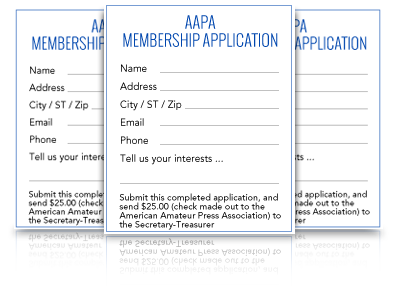Selecting Body Type Styles
by Sheldon C. Wesson
- Originally published in the March 1971 (Vol. 35, No. 3) American Amateur Journalist.
Selection of a body type by a beginning printer is probably the most important decision he makes. It immediately sets the artistic tone for his amateur journal. It limits the range of display faces which he may use. Many types limit the range of papers which he may successfully use as well.
The choice of a body type is a commitment to a style -- a choice usually made after the young printer has dabbled for some time with a variety of heterogeneous types which he has picked up here and there.
Don't misunderstand me. It is great to have a lot of type faces around for fun printing. But the magazine-type amateur journal, of some literary and/or artistic "quality" ambition, requires a sort of typographic commitment. And so the new amateur printer asks after awhile, "What body type shall I use?"
To start with: buy foundry type. Your text type will be set and distributed over and over again -- sometimes several times for one issue of your paper -- and will get much more wear from handling and presswork than display type which is used to the extent of a couple of words now and then for headings and titles.
Foundry type means money. It means that a full California case of 10-point may represent the biggest single investment in your shop aside from the press itself -- maybe more, if you use a small hand press! But it is a sound, economical investment in the long run over Monotype or other soft-metal types. Furthermore, you can use foundry type for a couple of years -- a fraction of its useful life -- and sell it to another amateur at a reasonable discount if you grow tired of it.
Which face? If you have all the money in the world to spend, the answer is, "Whichever face pleases you." Go ahead...buy European types. Enjoy. But be sure you pick a face that will be in production for some years so you can be sure of getting sorts later, if needed. That, incidentally, is true of domestic foundry type as well. A "standard" face is liable to be available, in a range of sizes, for many years. Exotica, whether foreign or domestic, may narrow down in size availability after a few years of commercial popularity.
Watch the amateur journals. See which body types please your eye...which ones seem to adapt well in coloring, legibility, and in blend-ability with different display faces. Write the printers whose types please you. Ask for the names, sources of supply, etc. Ask how the faces react on book paper or on calendered paper. Remember: versatility as well as eye-appeal is what you want. You'll be using the same type in many different ways.
There is another advantage to "standard" types over more exotic faces. When you scrounge in the used-equipment houses, or buy/sell/swap with other amateurs, you are more likely to find additional sizes of the same face (with italics, bold face, etc.) popping up.
When you've made the decision, act! Save up to buy one font of caps, one of figures, one of points, three of lower case. Or, 2-1-1-5. Plan to buy one complete font of italics and one of small caps at the same time. You need them for good "book" style composition (even if you use the small caps once a year).
With a firm commitment to a face, read up on it. Find out what the experts say how wide it can be set in 10-point (or 12-point or 9-point on 10, whatever you choose) and how much it should be leaded for maximum legibility. Then adapt all this good technical knowledge to the specifications of your amateur journal's page as closely as you can.
Having taken this most important step, then go ape over display types. Buy and swap used fonts with other amateurs. Experiment. Keep the ones that you like with your body type. Resell the ones you don't like. Design. Create. Enjoy. Enjoy. Enjoy!
JOIN AAPA!
Become A Member!
 Amateur journalism is a unique activity. Amateur journalists publish journals on paper & online & come from many perspectives: from deluxe letterpress printed journals, to Xeroxed newsletters, to artistically designed cards and ephemera. We embrace the spirit of being amateurs – loving what we do for pure joy and not financial gain – while creating top quality journals, zines, and homemade publications.
Amateur journalism is a unique activity. Amateur journalists publish journals on paper & online & come from many perspectives: from deluxe letterpress printed journals, to Xeroxed newsletters, to artistically designed cards and ephemera. We embrace the spirit of being amateurs – loving what we do for pure joy and not financial gain – while creating top quality journals, zines, and homemade publications.
Members receive ...
- The monthly bundle mailed via the postal service
- Access to the website and e-journals
- e-mailed updates
- Ability to publish your stories on AAPA


 |
|